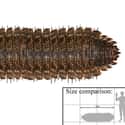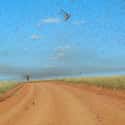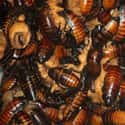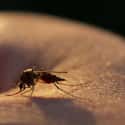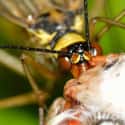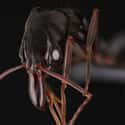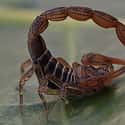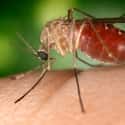-
(#1) If Earth's Oxygen Levels Increased By Just 15%, Some Bugs Would Be Able To Grow As Large As Humans
If you think bugs are gross now, you can thank your lucky stars you didn't grow up during the Carboniferous Period. That era took place between 359 to 299 million years ago, and it was home to some of the largest bugs to ever exist. Our atmosphere consisted of 35% oxygen back then, significantly more than the 21% level we have today. Scientists believe the high levels of oxygen were responsible for the mammoth insects and arthropods of the period.
Back then, you could find dragonflies the size of seagulls, with 2.5-foot wingspans. There were cockroaches and scorpions that grew up to 3 feet long. There was even a species of millipede that grew to be larger than the average human.
-
(#2) If You're A Regular Coffee Drinker, You Might Drink 130,000+ Insect Parts A Year
Everyone's heard the myth about people accidentally eating spiders in their sleep, but you don't have to be unconscious to accidentally eat a bug. Insects are pretty much a part of our daily diet. The FDA has a legal allowance of how many bugs can end up in your food before it's a problem.
For example, regular coffee drinkers are legally allowed to ingest as many as 136,000 insect parts every year. If you consume any products made from wheat flour, you're eating as many as 91,000 insect parts annually.
-
(#3) Five Well-Coordinated Locust Swarms Would Be Able To Wipe Out The Entire Earth
From the Old Testament to the present day, locust swarms can wreak havoc of biblical proportions. In the 1870s, one such swarm descended out of the Rocky Mountains and laid waste to the Great Plains. One farmer reported losing 15 acres' worth of corn in just three hours. A single locust swarm can cover as much as 20% of the entire planet's land area at once, consuming 200 tons of plant matter in a single day. Just five of these swarms would be enough to cover all the land on Earth and, having wiped out the world's agricultural industry, would likely lead to mass starvation.
Once locusts run out of food, it's likely they would start eating each other next. Research has shown that swarming locusts are not above cannibalism - it's actually the most efficient way for them to get some protein and salt in their diet.
-
(#4) You Almost Certainly Have Demodex Mites Living On Your Face
The bad news is there are demodex mites on your face right now. The good news is that they're harmless. There are two species of mite that live exclusively on our faces: Demodex folliculorum and Demodex brevis. They aren't insects but arthropods and closely related to insects like spiders and scorpions.
These creatures inhabit two different environments on your face. D. folliculorum tend to make their homes inside facial pores. D. brevis lives in your sebaceous glands, which is responsible for excreting certain oils from your hair follicles.
-
(#5) If You Were In A Subway Station With A Madagascar Hissing Cockroach, Its Hissing Could Be Mistaken For An Oncoming Train
Cockroaches are pretty much universally loathed - the kings of the gross bug world - and Madagascar hissing cockroaches are a step above the rest. These giant roaches are named after the hissing sound they make when they feel threatened. It's not only an awful noise, but a dangerously loud one as well.
The hiss can be as loud as 90 decibels by some estimates, which is as loud as a moving subway. Sounds greater than 85 dB are considered harmful to the human ear.
-
(#6) Mosquitoes Kill More People Every Year Than Humans Do
While spiders, snakes, and other sinister predators are some of the scariest animals in the world, they are far from the deadliest. That title belongs to the mosquito. Mosquitoes end the lives of more people than any other animal on Earth, with up to 725,000 victims annually. To put that in perspective, annual human slayings come in at about 475,000.
This is largely because mosquitoes carry all sorts of diseases: Malaria, dengue fever, yellow fever, encephalitis, and the Zika virus are just a few examples. Malaria alone takes the lives of 600,000 people annually, leading some to suggest we focus on wiping out the pesky things for good.
-
(#7) People Are Being Eaten By Bugs Right Now
When somebody expires, bugs start showing up almost instantly to snack on the leftovers. In fact, bugs are so reliable at finding lifeless human bodies that forensic entomologists can tell how long a body has been deceased based on what kinds of bugs are present.
Given that an estimated 6,316 people perish every hour, it's safe to say there isn't a moment that goes by without somebody losing their life. Since bugs will start feasting on a body well under an hour after its demise, it's also safe to say not a moment goes by in which a bug isn't eating a human being's body.
-
(#8) Ants Are Smart Enough To Engage In Organized Conflict, And They're Shockingly Human About It
Ants are among the few insects to engage in organized conflict, setting armies against armies in a fight to the end. There are roughly 10,000 species of ants, and each one goes about clashes in its own unique way.
Ant conflicts can be as barbaric as ours: Cannibalism, looting, and executions are all commonly practiced among ants. Army ants fight in a way similar to the ancient Roman legions. Some species use tactical deception to make themselves appear more powerful than their enemies, and weaker ants are used as cannon fodder on the front lines.
-
(#9) The 10 Quintillion Insects Alive Worldwide Outweigh Human Life
Roughly 1 million species of insect have been discovered by science - more than any other group of animals - but some estimates suggest there are up to 30 million species still waiting to be discovered. There are about 10 quintillion insects alive at any given moment, dwarfing humans in total mass.
If we compare our mass with the total mass of all insects, it's not even close: Insects weigh about 17 times more than humankind.
-
(#10) Humans Have Used Insects As Tools During Armed Conflicts
Human civilizations have tried to weaponize bugs countless times in the past, with varying degrees of success. Insects have been so common in armed conflicts that entomologists broke their usage into three distinct groups: insects as tools, insects as disease carriers, and insects as crop destroyers.
In the Second Parthian War, scorpions and disease-causing beetles were lobbed at the opposing Roman army, poisoning their troops and causing scarring skin lesions. The United States was accused of using insects in the Vietnam War to cause crop failure, and some societies have even launched plague-carrying insects into enemy territory. The use of insects as tools of armed conflict is also advancing into the 21st century with a potential fourth category of insect warfare. The study of insects is being increasingly used in advanced military technology, including drones and genetic warfare.
-
(#11) It Would Take More Than 1 Million Mosquitoes At A Single Moment To Completely Drain Your Body Of Blood
Ever wondered how many mosquito bites it would take to drain you of your blood? The staff at Business Insider has the answer. They based their figures on the Asian tiger mosquito, an invasive species in North America. These mosquitoes typically draw about 0.000005 liters of blood at a time, and human bodies have about 5.5 liters of blood.
If they were to bite all at once, you'd need 1.1 million Asian tiger mosquitoes to completely drain you. Then again, you only need to lose about 20% of your blood before organ failure begins to set in, so technically a mere 220,000 mosquitoes would be enough to do the job.
-
(#12) If All The World's Ants Were Lined Up, The Distance Would Stretch From Earth To The Moon And Back 1,500 Times
Ants are known for their complex societies and ferocious bites, and their combined armies put their numbers at around 10,000 trillion. Ants can range from between one inch in size to .08 inches. If we assume the average length of an ant is about half an inch, we can start to get a sense of how many ants 10,000 trillion really is. Lining up all ants from head to butt would result in a line of ants 789,141,414 miles long.
To put that in perspective, the distance from Earth to the moon is only 238,900 miles. That line would be long enough to reach the moon and back 1,500 times.
New Random Displays Display All By Ranking
About This Tool
It is obvious that bugs are not particularly popular bugs, but this does not mean that they are not interesting insects. Bugs are really smelly, when a bug is threatened, it releases irritating substances from special glands, repelling almost any predator with a sense of smell. They are very small and difficult to capture, and they like to live on the bed plank or mattress, so it is necessary to clean the bed regularly.
Would you mind take a few minutes to learn more about their natural history and abnormal behavior? The random tool introduced 12 creepy facts about bugs that almost nobody would like to know.
Our data comes from Ranker, If you want to participate in the ranking of items displayed on this page, please click here.











